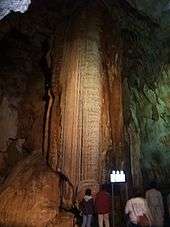Mine, Yamaguchi
| Mine 美祢市 | |
|---|---|
| City | |
|
Karst landscape of Akiyoshidai | |
 Location of Mine in Yamaguchi Prefecture | |
 Mine Location in Japan | |
| Coordinates: 34°09′47″N 131°12′30″E / 34.16306°N 131.20833°ECoordinates: 34°09′47″N 131°12′30″E / 34.16306°N 131.20833°E | |
| Country | Japan |
| Region | Chūgoku (San'yō) |
| Prefecture | Yamaguchi Prefecture |
| Government | |
| • Mayor | Akira Nishioka (since April 2016) |
| Area | |
| • Total | 472.71 km2 (182.51 sq mi) |
| Population (May 1, 2016) | |
| • Total | 25,857 |
| • Density | 54.70/km2 (141.7/sq mi) |
| Symbols | |
| • Tree | Live oak |
| • Flower | Cherry blossom |
| Time zone | Japan Standard Time (UTC+9) |
| City hall address |
326-1 Higashi-bun, Ōmine-chō, Mine City, Yamaguchi Prefecture (山口県美祢市大嶺町東分326番1号) 759-2292 |
| Website |
www2 |
Mine (美祢市 Mine-shi) is a city located in Yamaguchi Prefecture, Japan.
As of May 1, 2016, the city has an estimated population of 25,857 and a population density of 54.70 persons per km². The total area is 472.71 km².
History
The city was founded on March 31, 1954 by a merger of municipalities that departed from Mine District (Mine-gun).
On March 21, 2008, Mine absorbed the rest of Mine District, which consisted of towns Mitō and Shūhō, while the newly merged city retained the name, Mine.
Attractions
- Akiyoshidai Quasi-National Park, which includes the Akiyoshidai (秋吉台 Akiyoshi plateau) and Japan’s longest cave, the Akiyoshido (秋芳洞), the latter of which is designated a Special Natural Monument. Akiyoshidai is served by a natural history museum, visitor center, rest house, youth hostel and park headquarters building, and is traversed by a scenic roadway and several walking trails. Events include a fireworks festival in July, a “Karst Walk” in November, and an annual burning off of dry grasses in February called “Yamayaki”.
- Akiyoshido, Akiyoshido (秋芳洞). Towards the southern end of Akiyoshidai is the Akiyoshido cave, named by Emperor Hirohito on May 30, 1926 when he was still crown prince. This spacious cave is up to 100 meters wide and has 8.79 kilometers of passages, making it the longest in Japan and one of the longest in Asia. At the present time an approximately one-kilometer-long section of the cave is open to the public as a sightseeing course, with a walkway and bridge system, entering at the cave's lowest point and exiting via an artificial elevator. This portion of the cave is also well decorated with a variety of large and colorful speleothems.
Geology

The plateau consists of uplifted reef limestones of Paleozoic age, which were thickened by overfolding during the Akiyoshidai orogenic movement. Subsequent erosion has created an undulating karst landscape dimpled with many dolines and countless limestone pinnacles up to two meters in height. Beneath the surface lie hundreds of caves, a few of them quite significant geologically.
Numerous fossils of Pleistocene age have been found in these caves, including those of the Japanese rhinoceros, Stegodont elephant, Naumann elephant, Young tiger, and numerous other animals from the last interglacial period.
The area around Akiyoshidai was once heavily forested about 500,000 years ago. In the Jōmon period, the area served as a hunting ground and the bottoms of sinkholes as vegetable fields. Numerous Paleolithic artifacts have been recovered. As farming began in Japan, the local people eventually replaced the forested landscape with Japanese pampas grass for feeding their animals and thatching houses. Repeated cycles of burning the grass have kept trees from growing back since.
Transportation
Trains
- West Japan Railway Company(JR Nishi Nihon) stations
Roads
Expressway
- Mine Interchange
- Mine-nishi Interchange
External links
 Media related to Mine, Yamaguchi at Wikimedia Commons
Media related to Mine, Yamaguchi at Wikimedia Commons- Mine City official website (Japanese)
- Yamaguchi Prefecture official website (English)


